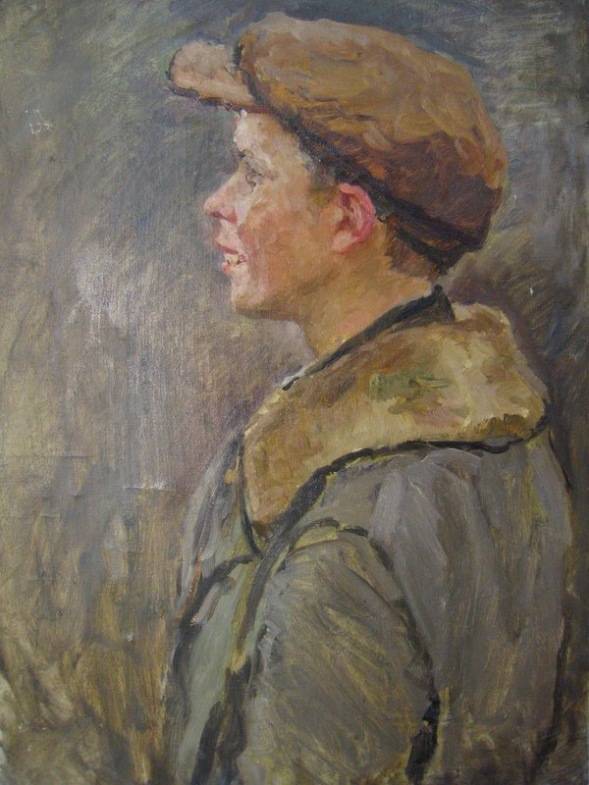Portrait of Peter Morezehen

Plastov, Arkadi
Presolinikha 1893 - 1972
Portrait of Peter Morezehen
Oil on Canvas
66 x 50cm
PROVENANCE:
Collection of the artist and by descent
Regina Gallery, Moscow
Private collection, England
Private collection, Switzerland
Arkady Aleksandrovich Plastov was born in Prislonikha, Simbirsk province, in 1893 and became the most famous of the Russian painters of the middle of the 20th century. He studied with D. I. Arkhangelsky in Simbirsk from 1908 to 1912. He studied at Stroganov College from 1912 to 1914. From 1914 to 1917 he studied sculpture at the Moscow College of Painting, Sculpture, and Architecture under S. Volnukhin.
Active in Prislonikha, Plastov began exhibiting his works in 1929. In 1931 he exhibited with the Union of Soviet Artists.
Little is known about his early career, since his works from the 1920s and 1930s were destroyed by a fire. By the late 1930s he was already a fully established master with a clearly defined range of themes.
Important shows include:
- 1939: “Twenty Years of the Workers’ and Peasants’ Red Army”; Moscow.
- 1947, 1949-1952, 1955: “All-Union Art Exhibition”; Moscow.
- 1960: “Soviet Russia”; Moscow.
Well-known works include:
- “Collective Farm Festival” (1937; Russian Museum)
- “The Bathing of the Horses” (1936-’38; Russian Museum)
- “Harvesting” (1945; Tretyakov Gallery)
- “Haymaking” (1945; Tretyakov Gallery)
- “Collective-Farm Threshing” (1949; Kiev Museum of Russian Art)
- “The Tractor Driver’s Supper” (1951; Irkutsk Art Museum)
- “Spring” (1954; Tretyakov Gallery)
Plastov became a member of the Russian Academy of Arts in 1947. This gave him the title of “acadmician” - one of the highest honors and most prestigious titles bestowed upon a Russian artist. He was awarded the Stalin Prize in 1946, and two Orders of Lenin. He was awarded the title ‘People’s Artist of the USSR.’ He received the Lenin Prize in 1966.
His works are in the permanent collections of the State Russian Museum in St. Petersburg, the Tretyakov Gallery in Moscow,and the Kiev Museum of Russian art, as well as other art museums and galleries world-wide.
Plastov was one of the great Soviet realists, and the outstanding socialist realist painter of the Stalin era. He died in Prislonikha in 1972.
His works have been widely published in many art books and journals, including:
- “A. A. Plastov.” Our Hermitage - One, Moscow, 2003.
- “Art in the Soviet Union.” Aurora Art Publishers, Leningrad, 1978.
- “Art Under Stalin.” Matthew Cullerne Bown. Holmes & Meier Publishers, New York. 1991.
- “Catalog of the Academy of Art of the USSR.” Fine Arts, Moscow, 1985.
- “A Dictionary of Twentieth Century Russian And Soviet Painters.” Matthew Cullerne Bown. Izomar Limited, London, 1998.
- “Kiev Museum of Russian Art.” Soviet Artist, Moscow, 1982.
- “Land and People”. Artist RSFSR (Russian Soviet Federal Socialist Republic), Leningrad, 1982.
- “Paintings from the Russian Museum Collection.” Aurora Art Publishers, Leningrad, 1975.
- “Russian Impressionism.” Harry N. Abrams, Inc., New York, 2000.
- “The Russian Museum, Leningrad. Paining.” Aurora Art Publishers, Leningrad, 1979.
- “The Soviet Character.” Aurora Art Publishers, Leningrad, 1986.
- “Soviet Fine Arts.” Fine Arts, Moscow, 1982.
- “Soviet Painting 1917-1973.” Soviet Artist, Moscow, 1976.
- “Soviet Impressionism.” Antique Collectors’ Club Ltd., Woodbridge, Suffolk, England, 2001.
- “The Tretyakov Gallery.” Aurora Art Publishers, Leningrad, 1974.
- “Umeni Sovetskeho Svazu.” Aurora Art Publishers, Leningrad, 1988.
“The USSR Academy of Arts.” Aurora Art Publishers, Leningrad, 1982
This portrait was painted by Plastov in the village Prisolonikha in the Simbirsk province where he lived all his life. Plastov delighted in portraying the village people exactly as he found them and he painted this boy several times. During and after WWII most of the able bodied men were enlisted into the Russian army and this left only children, women and the aged to carry on with the farming.
Quickly painted with a loaded brush Plastov creates an atmospheric and charming picture of a type which, along with his powerful landscapes, established an outstanding reputation during his own lifetime.


